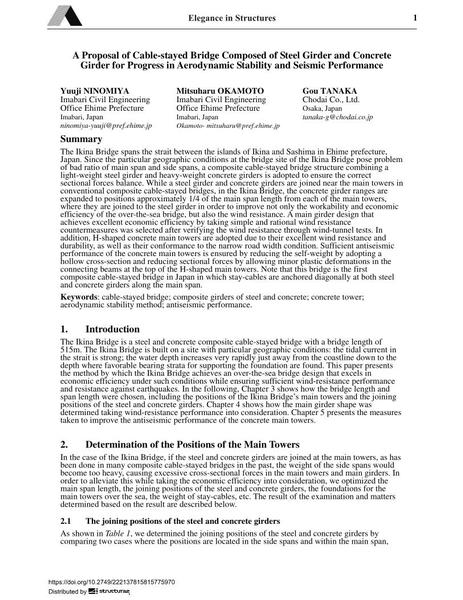À proposal of Cable-stayed Bridge Composed of Steel Girder and Concrete Girder for Progress in Aerodynamic Stability and Seismic Performance

|
|
|||||||||||
Bibliographic Details
| Author(s): |
Yuuji Ninomiya
Mitsuharu Okamoto Gou Tanaka |
||||
|---|---|---|---|---|---|
| Medium: | conference paper | ||||
| Language(s): | English | ||||
| Conference: | IABSE Conference: Elegance in structures, Nara, Japan, 13-15 May 2015 | ||||
| Published in: | IABSE Conference Nara 2015 | ||||
|
|||||
| Page(s): | 484-485 | ||||
| Total no. of pages: | 8 | ||||
| Year: | 2015 | ||||
| DOI: | 10.2749/222137815815775970 | ||||
| Abstract: |
The Ikina Bridge spans the strait between the islands of Ikina and Sashima in Ehime prefecture, Japan. Since the particular geographic conditions at the bridge site of the Ikina Bridge pose problem of bad ratio of main span and side spans, a composite cable-stayed bridge structure combining a light-weight steel girder and heavy-weight concrete girders is adopted to ensure the correct sectional forces balance. While a steel girder and concrete girders are joined near the main towers in conventional composite cable-stayed bridges, in the Ikina Bridge, the concrete girder ranges are expanded to positions approximately 1/4 of the main span length from each of the main towers, where they are joined to the steel girder in order to improve not only the workability and economic efficiency of the over-the-sea bridge, but also the wind resistance. A main girder design that achieves excellent economic efficiency by taking simple and rational wind resistance countermeasures was selected after verifying the wind resistance through wind-tunnel tests. In addition, H-shaped concrete main towers are adopted due to their excellent wind resistance and durability, as well as their conformance to the narrow road width condition. Sufficient antiseismic performance of the concrete main towers is ensured by reducing the self-weight by adopting a hollow cross-section and reducing sectional forces by allowing minor plastic deformations in the connecting beams at the top of the H-shaped main towers. Note that this bridge is the first composite cable-stayed bridge in Japan in which stay-cables are anchored diagonally at both steel and concrete girders along the main span. |
||||
| Keywords: |
cable-stayed bridge composite girders of steel and concrete concrete tower aerodynamic stability method antiseismic performance
|
||||
